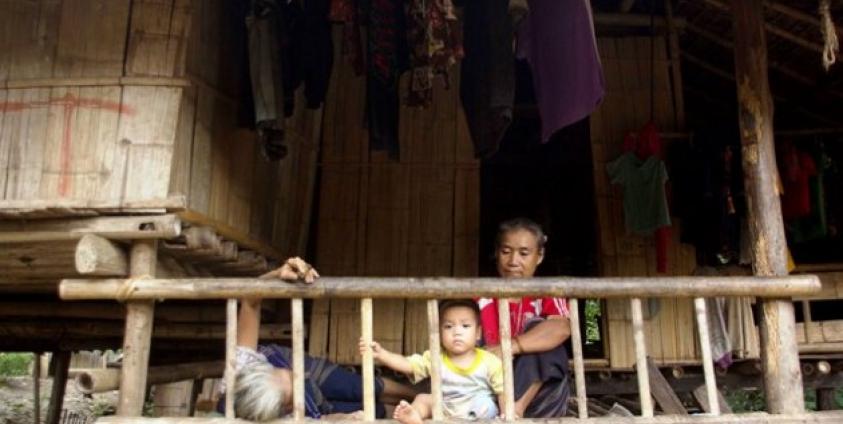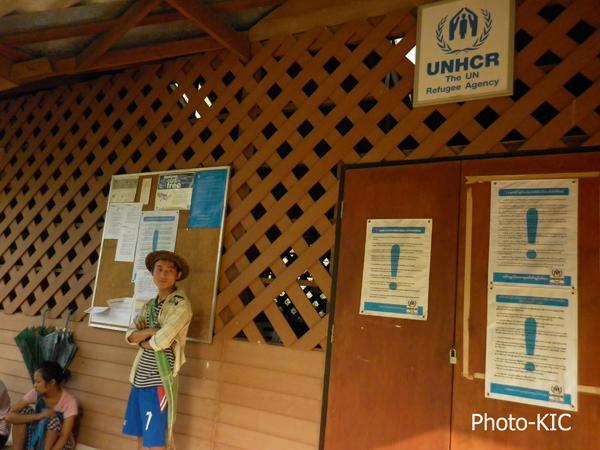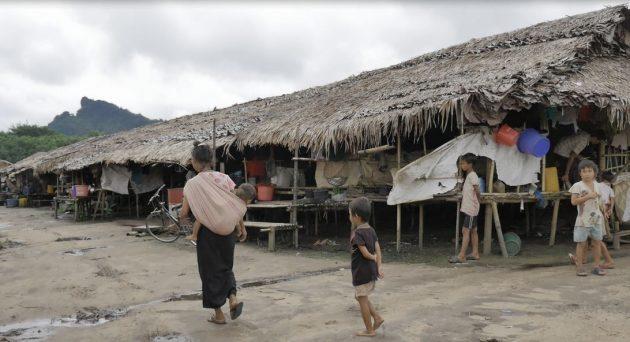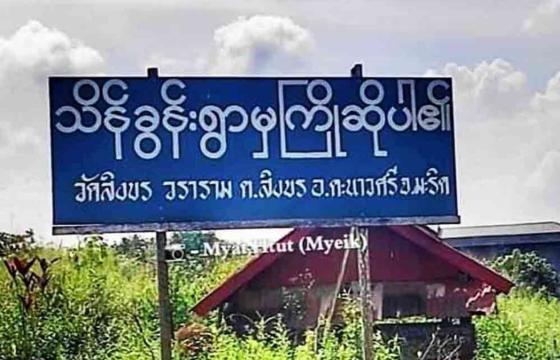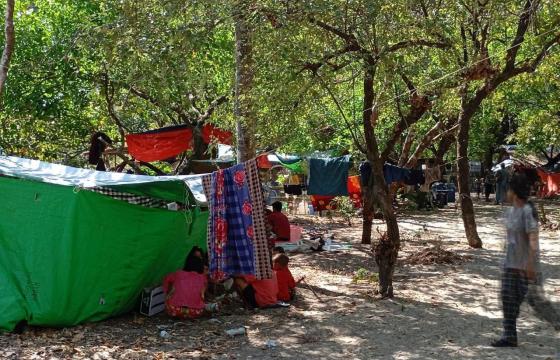Refugees from Burma are finding it difficult to stay, difficult to go home.
In Thailand, funding cuts to refugee camps have left over 100,000 displaced people from Burma to choose between trying to survive in deteriorating conditions and returning to a country not ready to receive them.
The refugees are spread throughout 9 camps perched on Thailand’s southwest border with Burma. The vast majority are from the Karen ethnic group, victims of a 6-decade long conflict with the Burmese government—the world’s longest civil war.
Many have called the claustrophobic collection of stilted bamboo huts home for over 30 years. Others born in the camps have known only a limited life outside of the barbed-wire fences that confine them. Unable to legally leave the camps to work, refugees have survived for most of the last three decades on the charity of international donors. But now, that aid has begun to dry up.
Funding cuts to organizations operating on the Thai-Burma border have been an ongoing process for the past seven years, beginning in 2010 with Burma’s shaky transition toward democracy. With an unprecedented number of displaced people—some 65 million worldwide—donors have turned their attention to more visible crises. Some have shifted their focus to the other side of the border, seeking to work officially with the Burmese government.
“It’s always a challenge to raise funds for food aid in a situation of protracted displacement where the needs are chronic but not life-threatening,” says Duncan McArthur, Myanmar Program Director at The Border Consortium. For twenty plus years, TBC has been the sole provider of food and shelter assistance to all nine refugee camps. They’ve seen their funding drop by nearly 50% between 2012 and 2016, a trend they expect to continue.
To cope, TBC has scaled back “non-core” activities and cut staff numbers and stipends, many of whom come from the refugee community. In addition to decreased employment opportunities, camps have seen losses in the quality of medical care and education, including clinic closures and rising school fees. By far the most pressing concern amongst refugees, however, is ration reductions.
Refugees in the camps rely heavily on a monthly ration of rice, yellow split peas, fortified flour, fish paste, and cooking oil. Since 2010, standard adult rations have dropped from 15 kilograms of rice per person to 9 kilograms, from 7.5 kilograms to 6 kilograms for children. In 2012, TBC restricted their food distribution, adjusting rations based on whether a family is classified as “most vulnerable,” “vulnerable,” “standard,” or “self-reliant.” Self-reliant households—1% of the camps’ population—no longer receive rations, while households determined to be vulnerable are given extra support. Still, those classified as most vulnerable receive only 13.5 kilograms of rice, below the standard 15 kilograms received by all refugees in 2010.
In 2012, when standard rice rations were 12 kilograms, TBC recognized that at 1,640 kilocalories per person per day, rations fell 22% below the 2,100 kilocalorie minimum recommended by SPHERE, which sets standards for humanitarian response.
“Looking for a Way Out”
Many refugees struggle to survive on the current rations. Umpiem Mai resident Aung Ngway resorted to breaking camp rules by sneaking out at night to forage for frogs and vegetables to help feed his wife and 4 children. He also sometimes illegally found work as a day laborer in a nearby village harvesting beans. But since the 2014 military coup in Thailand, authorities have cracked down on laws on refugees leaving the camps.
“Before there was more freedom to work as a day laborer, but now there is not, so I just stay home,” Aung Ngway said in a video interview with Karen News. If caught, he risked paying a fine or, for repeated offenses, having his food rations suspended. “We feel like chickens kept in a cage.”
His wife, Paw Baw, worried that their young daughter was malnourished. According to TBC, the rate of chronic malnutrition in the camp, which stunts physical and cognitive growth, was 35% in 2015, down from 41% in 2013. Still, the number remains “high” according to WHO standards. In contrast, the rates of acute malnutrition, which is potentially life threatening, stood at 2%, acceptable by WHO guidelines.
TBC efforts to diversify refugee diets have included a Community Agriculture Program, which provides training in organic farming methods and promotes community gardens as a source of fresh produce. But, as funding cuts continue, the future of these programs is uncertain.
According to Tu Kee, a senior official at Mae La Camp, ration reductions have led to other problems. Tu Kee claimed in an interview with Karen News that drug abuse, suicide, and theft are on the rise. A 2006 study by Premiere Urgence-Aide Médicale International found that 50% of adult camp residents suffer from mental health problems. “Refugees are looking for a way out, but they cannot find it, and they can’t do anything about it, so they lose hope,” Tu Kee said.
TBC has not cut rations since 2015, and intends to keep them at current levels for 2018. However, Mr. McArthur warns, “If refugee return rates increase, then the chances of ration cuts decrease,” but, “if departure rates stagnate, then the likelihood of ration cuts increase.” As stated in the TBC strategy report for 2017 to 2019, if refugee return is protracted, the safety and security of refugees remaining in the camps in Thailand will likely diminish.
Pushed to Return?
Over the past 4 years, between 10,000-15,000 refugees have gone back to Burma in so-called spontaneous returns. While significant, the numbers are well below expectations. The UNHCR’s planning figures for 2016 indicated that 45,000 refugees, nearly half the camp population, were “targeted to depart through assisted voluntary repatriation.” However, TBC statistics for 2016 estimate 2,300 people returned to Burma, with camp populations decreasing by a net 5% overall.
In response to the spontaneous returns and political changes within Burma, the UNHCR opened Voluntary Repatriation Centers (VRCs) in the camps. The centers are part of the UNHCR process of facilitated voluntary repatriation, which, according to UNHCR guidelines, means assisting refugees who have decided to return to their home country. The UNHCR may start facilitating voluntary repatriation when, “refugees indicate a strong desire to return voluntarily and/or have begun to do so on their own initiative, even when the UNHCR does not consider that, objectively, it is safe for refugees to return.”
The process of returning a refugee through the VRCs is a complex coordination of the Thai and Burmese governments and aid agencies. Refugees are provided counseling, mine risk awareness trainings, and medical screenings. They are also given cash assistance totaling 8,300 Thai Baht per person ($252 USD) in the form of transport, reintegration, and household support grants as well as 3 months worth of food assistance. Everyone who returns receives official documentation from the Burmese government, while forfeiting his or her refugee status.
So far, only 71 individuals have been successfully repatriated through the VRCs since they opened last year. Refugees cite the VRCs’ focus on individuals rather than whole communities, and Burmese government restrictions that keep the UNHCR from entering certain areas to where they want to return, as reasons for the seemingly low interest in the VRCs.
Additionally, in spite of the UNHCR’s efforts to coordinate with refugees and community-based groups, the centers have been met with fear and suspicion by some refugees.
Tu Kee, a Mae Lae camp official, says he believes ration cuts and the VRCs are signs that aid and government agencies want to push refugees to return. “Literally they want to force us to return and go away. I feel like they have found the way for us to return [by cutting our rations].”
The Thai government has repeatedly talked of closing the camps, as early as one month after Burma transitioned to a nominally civilian government in March 2011. Thailand also has a history of forcibly repatriating refugees, most notably 4,000 Hmong refugees to Laos in 2009.
Despite accusations and fears amongst refugees, UNHCR Senior Field Coordinator Peter Trotter states there is no evidence that the Thai government—or anyone else—is interested in forcibly repatriating refugees from Burma. “We don’t see that, we haven’t seen that, and we don’t expect to see that at any point in time, certainly not in the foreseeable future.”
He added that it’s important to distinguish between objective and subjective factors when dealing with the voluntariness of returning refugees. “I understand people may feel that circumstances are creating a situation that is putting them in a position of making difficult and uncomfortable decisions, but that’s not the same thing as being forced to do something. And right now, nobody is being forced.”
Still, there is a strong suspicion amongst the refugee population and cross-border organizations that conditions in the camp are indirectly pushing refugees into a repatriation they, and Burma, are not ready for.
According to the UNHCR’s voluntary repatriation guidelines, one of the most important elements of certifying refugees’ true voluntariness to return is their legal status in the country of asylum. “If they are recognized [as refugees], their rights are protected, and if they are allowed to settle, their choice to repatriate is likely to be free and voluntary. However if their rights are not recognized, if they are subjected to pressures and restrictions and confined to closed camps, they may choose to return, but this is not an act of free will.”
Thailand is not a party to the 1951 UN Convention, which laid down basic rights for refugees, such as access to courts, primary education, and work. Officially, there are no refugees in camps in Thailand, but ‘persons of concern’ hosted in ‘temporary shelters.’ They are not offered legal protection and are confined to closed camps, with their basic needs falling to outside and community-based organizations.
Mr. Trotter states he does not consider conditions in the camps, particularly those related to funding cuts, to be a push with respect to voluntary repatriation. “The funding situation isn’t targeted at particular individuals or situations in that sense. It is a series of very difficult decisions at a global level made within multiple state capitals about where they think their money is needed the most when there’s so much need everywhere.”
But at least one returnee cited difficulties surviving in the camp as a factor in her decision.
Naw Ohn Ye fled to Umphiem camp in 1985 when her Karen State village was caught in the crossfire between the Burmese and ethnic armies. “Every tree on the top of the mountain fell down after days of artillery blasts…after two days we left.”
She says that life in the camp became difficult when support began to shrink and her family grew. “[Donors to the camp] had supported us for a long time, so they couldn’t give us enough support for me and my family. So it became difficult for us to cope there.” Being back in Burma is better than life in the camp, because she can farm and forage for vegetables.
Burma Not Ready
The UNHCR maintains that repatriation should occur when refugees can return without fear of persecution, for their physical security, and access to land and livelihoods. There has been recent progress in Burma, including the first free national elections in over 50 years and the signing of a National Ceasefire Agreement between the government and 8 ethnic armed groups (3 of which were Karen) in 2015. However, it has not yet resulted in the significant changes that would allow these conditions to be met.
Despite a marked reduction in armed conflict, there is still ongoing fighting between the Democratic Kayin Buddhist Army (a breakaway faction from the Democratic Karen Benevolent Army) and Burmese government troops. Between September 2016 and September 2017, skirmishes displaced around 6,000 people to overcrowded camps in Mae Tha Waw, Karen State.
According to Internal Displacement Monitoring Center statistics, as of December 2016 there were 644,000 internally displaced people (IDPs) in Burma as a result of conflict and violence, two-thirds of which were in southeast Burma. These figures have prompted the question of whether returning refugees would merely be trading one camp for another.
When asked about the possibly of refugee return by Karen News, Nan Say Awa, a member of the Joint Ceasefire Monitoring Committee, asked refugees to, “Please wait,” to return, citing “daily” fighting between the DKBA and Burma Army and the struggles of IDPs in conflict areas.
Beyond the threat of violence, refugees must contend with unexploded mines. According to Mine Action Myanmar, there were 300 civilian landmine casualties last year, though human rights organizations claim these numbers are likely a gross underestimate. There has still been no large-scale demining effort in southeast Burma, as neither army will provide groups with the necessary access to do so. Additionally, in most cases no maps were drawn showing where the mines were laid, though multiple sources report many mines are laid in villages and fields used for farming.
Additionally, instances of land grabbing by the army and government are rampant throughout Burma, and some reports indicate they may have increased during the ceasefire period. Land issues account for 90% of complaint letters sent to the Karen State parliament so far this year, and sources within Burma have reported the army shoring up, even expanding, their bases in ethnic areas.
Refugees and IDPs cite land issues and the Burmese army’s presence as one of their chief concerns relating to their return.
Saw Paw Lae Ga Li La spoke to Karen News at a protest by IDPs in Ei Htu Hta camp demanding that the Burmese army leave their lands. “If we must return, then we want the Burma Army to leave our village. Otherwise, we don’t dare return. If they see women, they rape them, if they see villagers, they shoot and kill them. This past terrifies us and we do not want to experience it again.”
In addition to fears stemming from past abuses, Karen refugees, largely rural farmers, say the loss of their land is a direct threat to their livelihoods. According to a report by TBC, land tenure is one of the main barriers to food security and sustainable livelihoods for returning refugees. “There will be increased competition for natural resources in return areas, which may stop returnees from being able to develop sustainable livelihoods and attaining food security.” On top of land grabs by the government, returnees may find their land has been occupied by other families during their absence, necessitating a plan for the redistribution of land to former refugees and IDPs.
Even if refugees manage to find land upon their return, southeast Burma is still plagued by a severe lack of development, remnants of the oppressive military regime and six decades worth of conflict. A UNHCR review of villages to which refugees have returned found they overwhelmingly lacked the availability of key resources. Only 30% had access to a water source, while less than 10% had a health facility, and less than 5% a high school.
These are the conditions to which Paw Lwe Moo, who left Umphiem Camp for a returned site for displaced communities and refugees in Myawaddy Township last year, found when she arrived. “For now we can say that for our children and ourselves, the healthcare and food supply are not sufficient,” she said. “Our children have to go to school very far…we have a small clinic here, but we can only get paracetamol when we go there. It is hard to get drinking water if we have no money, because we have to buy purified water for drinking and the running water has limestone in it. It’s scary to drink. Even when we boil it, the residue sticks on the kettle, so we dare not to drink it.”
Development in Burma has become the focus of international groups since the 2011 political transition, and they have increasingly chosen to pull aid from the border in favor of making legal agreements with the Burmese government. This is a behavior, according to Peter Trotter, that the UNHCR encourages, in an effort to stimulate development and create conditions conducive for refugees to return.
But Saw Po Cho, secretary of the Karen Office of Relief and Development, says that funneling aid through Yangon means it does not reach those most in need, due to restrictions the government places on aid groups entering combat zones or areas controlled by ethnic governments. “After they follow the government’s laws, they cannot go to the places or areas where there is armed conflict, or the [rural areas] where the government says you cannot go. Actually, the people who really need help are in the [rural areas].” He suggests that donors offer more support grassroots organizations with access to these areas.
Despite the challenges, refugees who have spoken to Karen News say they will return if guarantees for their security, land, and livelihoods are in place.
Naw Poe Gaw, a camp leader at Ma Ra Ma Luang camp, says that in surveys carried out by camp administrators, most refugees wish to return to their homeland if their leaders take responsibility for their security. “Repatriation should be with full security and support…[it] should be with dignity, not just a simple return. It should be according to the plans of Karen leaders with [input] from both sides.”
Right now, she says, is not the time for refugees to return. “We do not know how much security we will have…there are no livelihood or jobs plans for us yet. The Karen leaders do not have any plans for us yet. Right now, if we return home, it will be meaningless for us.”
 With peace talks between the Karen National Union (KNU) and the Burmese government stalling, neither side has prioritized refugee return. The UNHCR and community-based groups say it is still too early for a coordinated plan of refugee return, as it is largely dependent on the political process.
With peace talks between the Karen National Union (KNU) and the Burmese government stalling, neither side has prioritized refugee return. The UNHCR and community-based groups say it is still too early for a coordinated plan of refugee return, as it is largely dependent on the political process.
If refugee demands for guarantees seem overly cautious, it is with good reason. In 1996, the UNHCR facilitated the repatriation of 200,000 Rohingya refugees from Bangladesh back to Rakhine state in Burma, despite them being denied citizenship by the ruling military junta, and no durable solution in place for years of ethnic conflict. This year, the Rohingya have grabbed headlines as tensions boiled over into a massive humanitarian crisis, with 600,000 Rohingya fleeing back to Bangladesh, in an alleged instance of “ethnic cleansing,” by the Burmese government. Without a long-term plan for their return and significant political progress, Karen refugees risk facing a similar situation, with the collapse of their tenuous ceasefire and a renewed conflict.
The consensus amongst the refugee community and the organizations that serve them is that now is not the time for a large-scale return of refugees to Burma. “We are not at a point where [the UNHCR] has said or either of the two governments have said that things are so good in Myanmar that people must go home,” Peter Trotter says.
A Solution for All
For some, however, that point may never come.
Eight percent of the refugee population is Muslim. Due to recent outbreaks of violence and anti-Muslim sentiment in Burma, many Muslims feel returning is not an option.
Du Du, a refugee in Mae La camp, says that while all ethnic groups will face challenges upon returning, Muslims are particularly vulnerable. “We are not recognized as citizens…we do not get any rights. The National Identity Card was provided to every ethnicity [in Burma] in 2014 and 2015, however no one in the Muslim community got the card. We have been living in Myanmar more than a hundred years, but we do not have the rights to become citizens.” A 1982 law restricts full Burmese citizenship to members of 135 “national races” that supposedly lived within the country’s boundaries before the British invasion in 1824.
There are also those for whom going back to Burma would not be going home. Saw Lwe K’pru Soe was a young teacher in Umpiem Mai camp when he spoke to Karen News in 2015. “When we talk about returning, this is meaningless. I don’t have any experience living back there. If I go back, I will have to start my life again from zero. I was born in a refugee camp. My parents are from Burma…,I have not been recognized [as either Thai or Burmese]. I was born here and live my whole life here in Thailand until I am 20, but I have no legal records or documents such as citizenship.” Saw Lwe K’pru Soe has since been resettled to Canada, but for many of the refugees remaining in the camps, that is no longer an option.
The UNHCR offers three solutions for refugees: repatriation back to their home country, integration into the host country, or third country resettlement. For those who cannot return to Burma, third-country resettlement was for many years the most promising option.
But now, large-scale resettlement has ended, with only a few slots available for those with strong cases. The U.S., who accounted for 75% of the over 100,000 refugee resettlements since it became an available in 2005, ended their group resettlement program in 2014. Resettlements have dropped from a peak of over 16,000 in 2008 to just 1,700 this year. Approximately 35% of those living in the camp are not officially registered as refugees, making them illegible for resettlement.
For those who wish to remain legally in Thailand, they must first return to Burma and gain the necessary documentation to come back as migrant workers. This could offer a solution for those without other options, though workers have claimed problems with obtaining the necessary identification and permissions through the Burmese government.
Mr. Trotter says that for the UNHCR, it is too early to begin to think of solutions for those who lie in the grey area, but that he is confident that when the time is right, they will find an answer. “We all hope that refugee status and being a refugee is not a lifetime situation,” he says, “We all hope for a durable solution.”
That solution remains elusive. But refugees worry that talk of repatriation as the immediate and universal answer will further the impression the crisis as ended—while their needs have not. This, they fear, will perpetuate funding losses from international donors that will make returning a necessity, not a choice.
For now, the Karen people who fled conflict in Burma are left to live with that uncertainty.
** This article, written by freelance journalist Kaelyn Lynch, is contributed to and first published on Karen News website.


